In the 1940s, Hollywood became the magnet for expatriate actors, writers, intellectuals and musicians. And it brought together two Russian composers who really didn’t like each other at all. Rachmaninoff and Stravinsky had no interest in each other’s compositions, but Rachmaninoff apparently telephoned his biographer and said, “As I know how much Igor Fedorovich has always disliked my compositions . . . and he must know my attitude to modern music, I’m not sure whether I could invite him and his wife to my house—which I’d love to do—because I don’t know how he would receive my invitation.”

Igor Stravinsky, 1910
In the event, Vera Stravinsky responded positively, and cordial dinners were arranged at both houses. Stravinsky’s Russian cook, Yevgenia Petrovna, prepared simple but delicious dishes, and Stravinsky always ate dinner wearing a beret because he was afraid of the draft. They apparently had lively discussions on musical matters, including managers, concert bureaus, agents and royalties, but not one word about composition. And Stravinsky did mention that he had a decided fondness for honey.
Igor Stravinsky: Four Norwegian Moods

Royal jelly honey
Stravinsky loved honey, but it was not just any type. Rather, it had to be royal jelly honey! This specialty secretion is used in the nutrition of larvae as well as adult queens. Copious amounts of royal jelly are fed to them in specially constructed queen cells, and it was—and apparently still is—widely marketed as a dietary supplement. Stravinsky carried jars of royal jelly to stir in his tea with him all the time, but on a visit to Israel in 1962, he ran out. When somebody managed to secure a jar, Stravinsky rejoices, “This will bring back my youth.” At any rate, back in 1942 Stravinsky was working late on his Four Norwegian Moods when he heard footsteps outside on the porch. The doorbell rang, and Stravinsky looked up at a “six-and-a-half-foot scowl,” belonging to Rachmaninoff. But Rachmaninoff was not scowling that evening but held in his hand an immense jar of royal jelly honey!
For more of the best in classical music, sign up for our E-Newsletter
